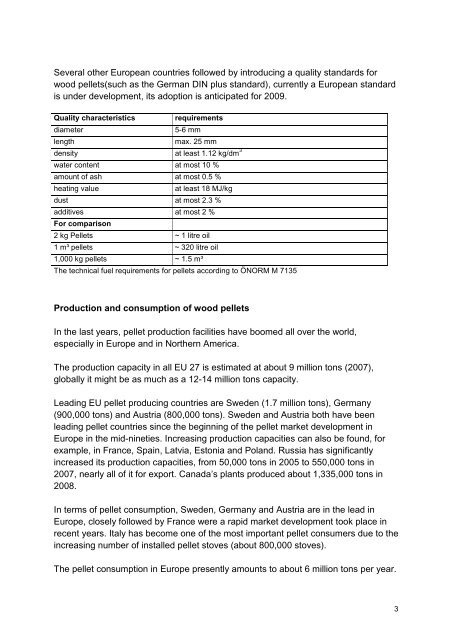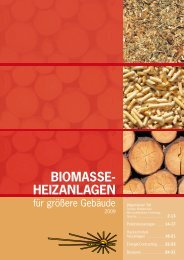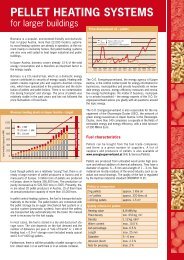Key Issues for Wood Pellet Market Development
Key Issues for Wood Pellet Market Development
Key Issues for Wood Pellet Market Development
You also want an ePaper? Increase the reach of your titles
YUMPU automatically turns print PDFs into web optimized ePapers that Google loves.
Several other European countries followed by introducing a quality standards <strong>for</strong><br />
wood pellets(such as the German DIN plus standard), currently a European standard<br />
is under development, its adoption is anticipated <strong>for</strong> 2009.<br />
Quality characteristics<br />
requirements<br />
diameter<br />
5-6 mm<br />
length<br />
max. 25 mm<br />
density at least 1.12 kg/dm 3<br />
water content at most 10 %<br />
amount of ash at most 0.5 %<br />
heating value<br />
at least 18 MJ/kg<br />
dust at most 2.3 %<br />
additives at most 2 %<br />
For comparison<br />
2 kg <strong>Pellet</strong>s ~ 1 litre oil<br />
1 m³ pellets ~ 320 litre oil<br />
1,000 kg pellets ~ 1.5 m³<br />
The technical fuel requirements <strong>for</strong> pellets according to ÖNORM M 7135<br />
Production and consumption of wood pellets<br />
In the last years, pellet production facilities have boomed all over the world,<br />
especially in Europe and in Northern America.<br />
The production capacity in all EU 27 is estimated at about 9 million tons (2007),<br />
globally it might be as much as a 12-14 million tons capacity.<br />
Leading EU pellet producing countries are Sweden (1.7 million tons), Germany<br />
(900,000 tons) and Austria (800,000 tons). Sweden and Austria both have been<br />
leading pellet countries since the beginning of the pellet market development in<br />
Europe in the mid-nineties. Increasing production capacities can also be found, <strong>for</strong><br />
example, in France, Spain, Latvia, Estonia and Poland. Russia has significantly<br />
increased its production capacities, from 50,000 tons in 2005 to 550,000 tons in<br />
2007, nearly all of it <strong>for</strong> export. Canada’s plants produced about 1,335,000 tons in<br />
2008.<br />
In terms of pellet consumption, Sweden, Germany and Austria are in the lead in<br />
Europe, closely followed by France were a rapid market development took place in<br />
recent years. Italy has become one of the most important pellet consumers due to the<br />
increasing number of installed pellet stoves (about 800,000 stoves).<br />
The pellet consumption in Europe presently amounts to about 6 million tons per year.<br />
3
















